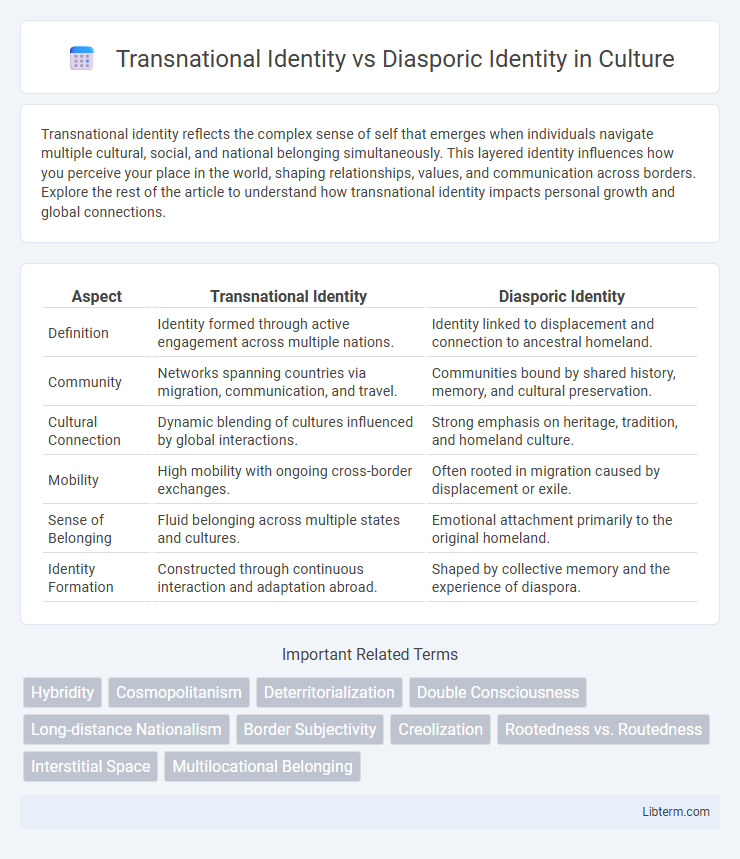Transnational identity reflects the complex sense of self that emerges when individuals navigate multiple cultural, social, and national belonging simultaneously. This layered identity influences how you perceive your place in the world, shaping relationships, values, and communication across borders. Explore the rest of the article to understand how transnational identity impacts personal growth and global connections.
Table of Comparison
| Aspect | Transnational Identity | Diasporic Identity |
|---|---|---|
| Definition | Identity formed through active engagement across multiple nations. | Identity linked to displacement and connection to ancestral homeland. |
| Community | Networks spanning countries via migration, communication, and travel. | Communities bound by shared history, memory, and cultural preservation. |
| Cultural Connection | Dynamic blending of cultures influenced by global interactions. | Strong emphasis on heritage, tradition, and homeland culture. |
| Mobility | High mobility with ongoing cross-border exchanges. | Often rooted in migration caused by displacement or exile. |
| Sense of Belonging | Fluid belonging across multiple states and cultures. | Emotional attachment primarily to the original homeland. |
| Identity Formation | Constructed through continuous interaction and adaptation abroad. | Shaped by collective memory and the experience of diaspora. |
Defining Transnational Identity: Key Concepts
Transnational identity refers to individuals who maintain active connections across nation-states, blending cultural, social, and political ties from multiple countries. Key concepts include hybridity, where identities transcend singular national narratives, and simultaneity, emphasizing the ongoing engagement with various cultural contexts. This identity challenges traditional notions of belonging by highlighting fluid, multi-sited experiences that resist fixed geographical boundaries.
Understanding Diasporic Identity: Core Characteristics
Diasporic identity is characterized by a profound connection to a homeland, often preserved through collective memory, culture, and traditions despite geographic displacement. It involves a continuous negotiation between maintaining ancestral roots and adapting to the host society, creating a dynamic and hybrid sense of self. This identity emphasizes shared historical experiences, resilience, and a sense of belonging that transcends national borders.
Historical Contexts of Transnational and Diasporic Identities
Transnational identity emerges from sustained connections across national borders, shaped by migration, globalization, and economic interdependence since the late 20th century. Diasporic identity is rooted in historical displacement and collective memory, often linked to forced migration events such as the Jewish, African, or Armenian diasporas. Both identities reflect complex interactions between homeland histories and host societies, influencing cultural preservation, political engagement, and social belonging.
Mobility, Migration, and the Shaping of Identities
Transnational identity emerges from continuous mobility and sustained connections across multiple nation-states, reflecting a dynamic sense of belonging that transcends geographical borders. Diasporic identity, shaped by migration and historical displacement, often centers on collective memory, cultural preservation, and a longing for a homeland. Both identities involve complex negotiations of space and self, influenced by factors such as migration patterns, social networks, and transnational communication technologies.
Cultural Retention versus Integration
Transnational identity emphasizes maintaining strong cultural retention through continuous connections with the homeland, supporting language preservation, traditions, and collective memory across borders. Diasporic identity often balances cultural retention with integration into the host society by adapting customs and participating in local social, economic, and political spheres. Both identities navigate complex processes of identity formation where cultural retention coexists with varying degrees of integration, shaping hybrid or layered experiences.
Hybridization: Negotiating Multiple Belongings
Transnational identity reflects the fluid negotiation of belonging across multiple national and cultural spaces, emphasizing the continuous connection and interaction between host and homeland societies. Diasporic identity underscores a collective memory and shared history rooted in displacement, often involving a strong emotional attachment to an ancestral homeland. Hybridization in both identities involves the dynamic blending of cultural practices, languages, and social norms, allowing individuals to construct multifaceted selves that defy singular national or ethnic categorization.
Role of Technology in Identity Formation
Technology acts as a crucial catalyst in shaping both transnational and diasporic identities by enabling continuous, real-time communication across borders, facilitating the preservation and evolution of cultural ties. Digital platforms allow diasporic communities to maintain linguistic, cultural, and social practices while simultaneously fostering hybrid identities that blend homeland and host country influences. Online networks and social media empower individuals to construct dynamic, multifaceted identities that transcend geographic limitations and support collective memory and solidarity within dispersed populations.
Challenges of Belonging and Exclusion
Transnational identity often faces challenges of belonging due to conflicting cultural norms and expectations across multiple nations, resulting in a fragmented sense of community. Diasporic identity encounters exclusion through social and political barriers in host countries, where individuals may be marginalized based on ethnicity or nationality. Both identities grapple with maintaining cultural heritage while negotiating acceptance within diverse social landscapes.
Case Studies: Comparative Perspectives
Transnational identity emphasizes ongoing connections across national borders, fostering hybrid cultural affiliations evident in case studies like Mexican migrants in the U.S. who maintain simultaneous attachments to both countries. Diasporic identity centers on collective memories and homeland nostalgia, as seen in the Armenian diaspora's preservation of cultural heritage despite geographic dispersion. Comparative analyses reveal that transnationalism often prioritizes fluid mobility and economic ties, whereas diasporic frameworks highlight historical trauma and community solidarity within dispersed populations.
Future Trends in Global Identity Formation
Transnational identity emphasizes the fluidity and multiplicity of belonging across national borders, driven by increased migration, digital connectivity, and global economic integration. Diasporic identity centers on shared heritage and collective experiences of displacement, often maintaining strong emotional ties to the homeland while adapting to host societies. Future trends in global identity formation suggest a blending of these concepts, where hybrid identities emerge through transnational networks and diasporic communities leveraging technology to sustain cultural memory and foster global solidarity.
Transnational Identity Infographic

 libterm.com
libterm.com